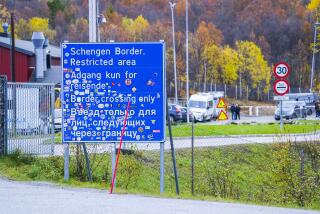Thief-Watching on Ex-Cold War Frontier
- Share via
ALARYTKO, Finland — Forty years ago, Russian border patrols tried to recruit Finns as Soviet spies. Now, Finnish guards watch for Russian thieves and hawkers out for a fast buck in the West.
“They used to shout, ‘Finland boy! Come spy for us!’,” said Jaakko Koskela, 55, a farmer who has lived near the border all his life. “Today, we are lucky if we see a Russian patrol in many months.”
Koskela is one of about 400 Finns who live within 2 miles of the frontier that stretches nearly 800 miles from the Baltic Sea to the Arctic. He fishes in the Vaalimaa River, which runs past his back yard and forms the border at that point.
The line was drawn in 1944, after Finland lost a war with the Soviet Union.
“In those days, shooting could be heard every day on that side,” said Koskela’s wife, Irma. “Russian officers shouted propaganda and there were lots of border patrols near our house.”
Now, Koskela said, it is “probably the most secure place in the world to live in. Finnish border patrols walk through our property every day, and we need not lock our doors.”
Not so a few miles north on the main highway from Helsinki to St. Petersburg, where shoplifting and burglaries of summer houses have increased.
“It started last summer and has become worse as the number of tourists has grown,” said Helge Tyni, the police chief at Hamina, 20 miles west of the frontier. “We have caught Russians stealing from cars and breaking into cottages.”
Reijo Vuorela, who runs a store and cafeteria at Vaalimaa, the main border checkpoint, said he often catches Russians shoplifting.
“Sometimes it’s as many as five a day,” Vuorela said. “They also start their trading right here on my porch, selling anything they’ve managed to squeeze past the customs.”
Russians sell alcohol, tobacco and bric-a-brac at marketplaces and gas stations along the highway.
“They sell anything they can,” said Keijo Kolsi, police chief of Kotka, 35 miles from the border. “Even the women offer themselves to men for 30 markkaa ($7).”
Last year, 576,000 border crossings were recorded at Vaalimaa, 65% more than 1990. Officials expect 1 million this year.
In order to visit Finland, Russians must have a passport, visa and the equivalent of $38 a day for the amount of time they intend to spend in the country. They must pay duty on goods not for their own use, but seldom have enough Finnish money, so the items are confiscated, said Markku Huumonen, a customs inspector.
A teen-ager tried to bring in a chain saw, but “had no explanation for what she was going to do with the saw, so, as she was unable to pay the duty, we took it away from her,” he said.
One recent day, the corridor outside Huumonen’s office was lined with large, black plastic bags filled with such wares as cheap cameras, drills, briefcases, watches, Christmas tree decorations and binoculars.
Hundreds of confiscated bottles of vodka, sparkling wine and brandy lined the shelves of a storeroom.
“It’s more like a scrapheap than a customs office,” Huumonen said.
About 100 yards away, an armed Russian guard in a heavy overcoat paced back and forth at the frontier gate near his small concrete hut.
“We have good cooperation with the Russian guards and communicate with them several times a week,” said Ismo Karha, an immigration officer.
Finnish guards catch more than 100 people a year crossing the border illegally, mainly through the forest.
“Some Finns, too, try going over, but usually they are drunks going on a dare,” said Kari Hovi, a border officer.
Frontier officers say they do not believe discontented citizens of former Soviet republics will rush into Finland.
More to Read
Sign up for Essential California
The most important California stories and recommendations in your inbox every morning.
You may occasionally receive promotional content from the Los Angeles Times.













